How Should I Learn to Draw the Head
Practice–But Not Work
We are fierce believers that drawing the human face takes practice, but it isn't work. That is because there are rules to follow and an effort to put behind it, but the process isn't anything but something to revel in if you have artistic leanings.
So enjoy more than a dozen tips on drawing the human head from one of our favorite artists Paul Leveille and then see about further embarking on a portraiture voyage with the sketches and insights from Everett Raymond Kinstler, a seasoned expert whose book,Impressions and Observations, is a must-have for learning artists.
First, It's Not a Race
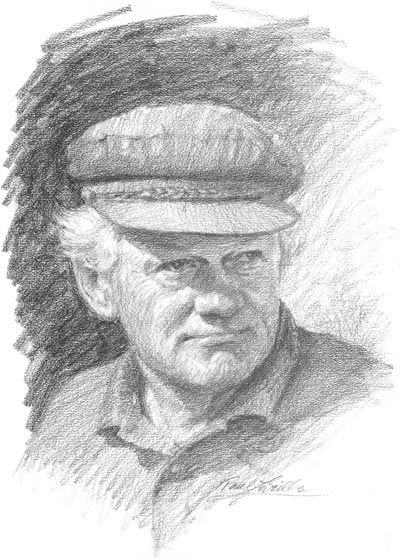
Drawing the human head correctly takes practice, but I never consider it work. To me, people are the most fascinating subjects to study and to draw. There's no chance for boredom since there are millions of different faces in this world. Even the same person takes on many looks with various expressions, clothing and lighting. In this article, I'll discuss the planes, features and proportions commonly used for drawing the "ideal" head.
First, while you're learning to draw a portrait, keep in mind that you're not in a race. Relax and progress at your own pace. As long as you keep drawing, you'll move forward. So pick up your pencil and enjoy the journey.
Begin With Simplified Planes
You can simplify the structure of the human head by eliminating details and breaking down the many shapes into a few basic planes (see Planes, below). Practice drawing these heads or, better yet, try working from a planed plaster (or plastic) cast. Once you feel more familiar with the head, start drawing from a live model.
Whether you're working from a cast or a live model, it's important to use one main light source to accentuate the planes. In the drawings here, the light source is above and to the left of the head. This particular lighting defines the features best by leaving shadow areas under the eyebrows, the nose, the upper lip and the chin. This lighting placement is one of the most desired for portraits since it reveals the forms of the features most effectively.
Planes

A Divide the area from the cheek down to the jaw into three basic planes: light, where the light source is brightest; darker, as the form starts to turn from the light; and darkest, as the form turns farthest from
the light.
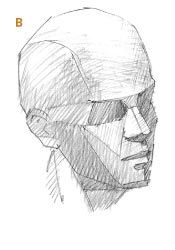
B The way light is revealed on the planes of the head tells us how the head is shaped. Here, the jaw is dark because it turns back, away from the light. By contrast, the ear is much lighter because it turns out from the jaw and catches the light.
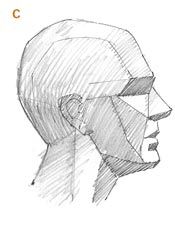
C The top and the back of the head have the same appearance that a ball lit from above would have. Starting from the top of the head—the brightest area—the head gets progressively darker as the planes turn from the light to the back of the head. This subtle value shift produces the look of a rounded structure.
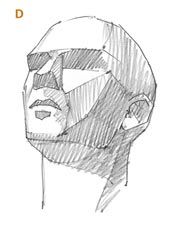
D Try drawing the head in simple planes in a variety of positions. Remember to leave out details—eyes, eyebrows, nostrils and other features—at this stage.
Render Head and Features
From the simplified planes of the head, we now progress to the study of the head and facial features (see Head and Features, below). At this point, I'd like you to squint at these drawings. Squinting allows you to eliminate the details of the features and see only the big shapes — the planes.
Head and Features
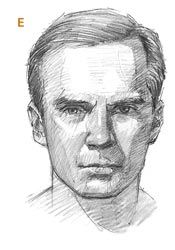
E The big planes are still visible, but they're softer. For example, the transition from light to dark on the cheeks is more subtle. The eyes stay back in the shadow plane under the brows and are darker than the forehead and cheek areas. The only bright light is in those highlighted areas.
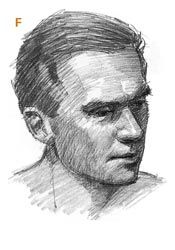
F This pose reveals the overall roundness of the head. The brightest areas appear on the model's right forehead, the hair above the cheek, and the mouth area below the nose. As the forms turn away from the light, they get darker.
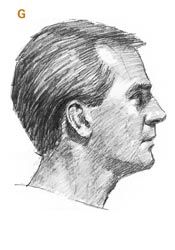
G We've seen the subtle changes in planes on the cheeks. This pose reveals the dark planes caused by the canopy effect of the eyebrows, nose and jaw.
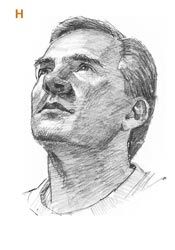
H The next pose lets us see what happens on the shadow side of the head. A lot of the planes are defined by reflected light. For example, the ear is entirely in shadow, but because it's turned at a slight angle to the head, it's picking up more reflected light. Keep in mind that even though the ear is lighter than the planes around it, it's still in shadow and therefore darker than features on the light side of the face.
Adult Head Proportions
All adult heads look different, and yet they all have two eyes, two ears, a nose and a mouth. When I work from a model or a photo, I start by lightly drawing the fundamental proportions in pencil or charcoal. Then I make adjustments specific to my particular subject as I go along by concentrating on what I see (above).
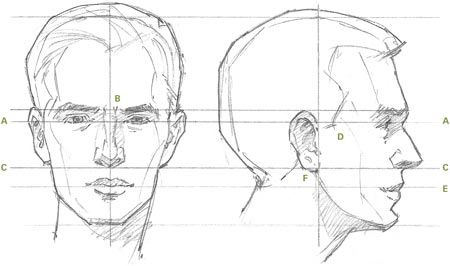
A From the top of the head to the chin, the eyes are positioned approximately in the middle.
B The eyes are about one eye-width apart.
C The bottom of the nose is halfway between the eyebrows and the chin.
D The ears are positioned between the horizontal lines of the eyebrows and nose.
E The mouth is placed between the nose and chin, about two-thirds of the way up from the chin.
F On the profile, notice that the ear is placed behind the vertical center line.
This article features excerpts from the bookDrawing Expressive Portraits by Paul Leveille.
How Should I Learn to Draw the Head
Source: https://www.artistsnetwork.com/art-mediums/drawing-human-head/
0 Response to "How Should I Learn to Draw the Head"
Post a Comment